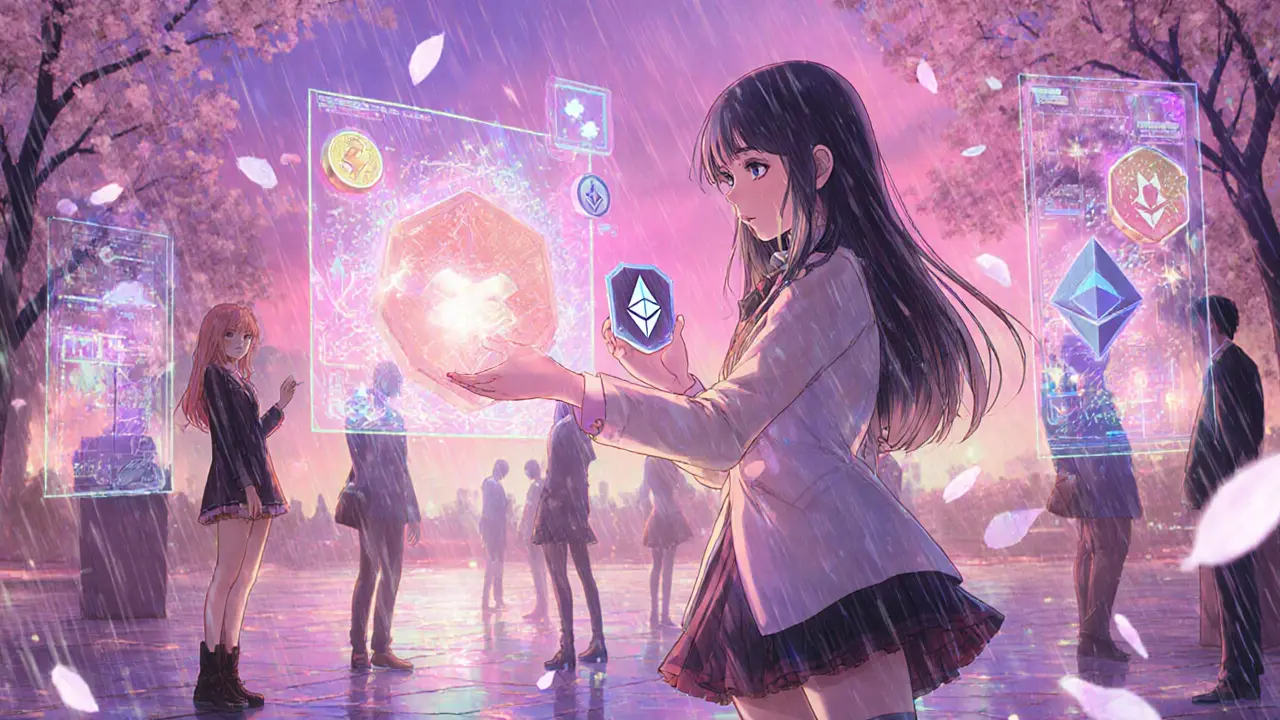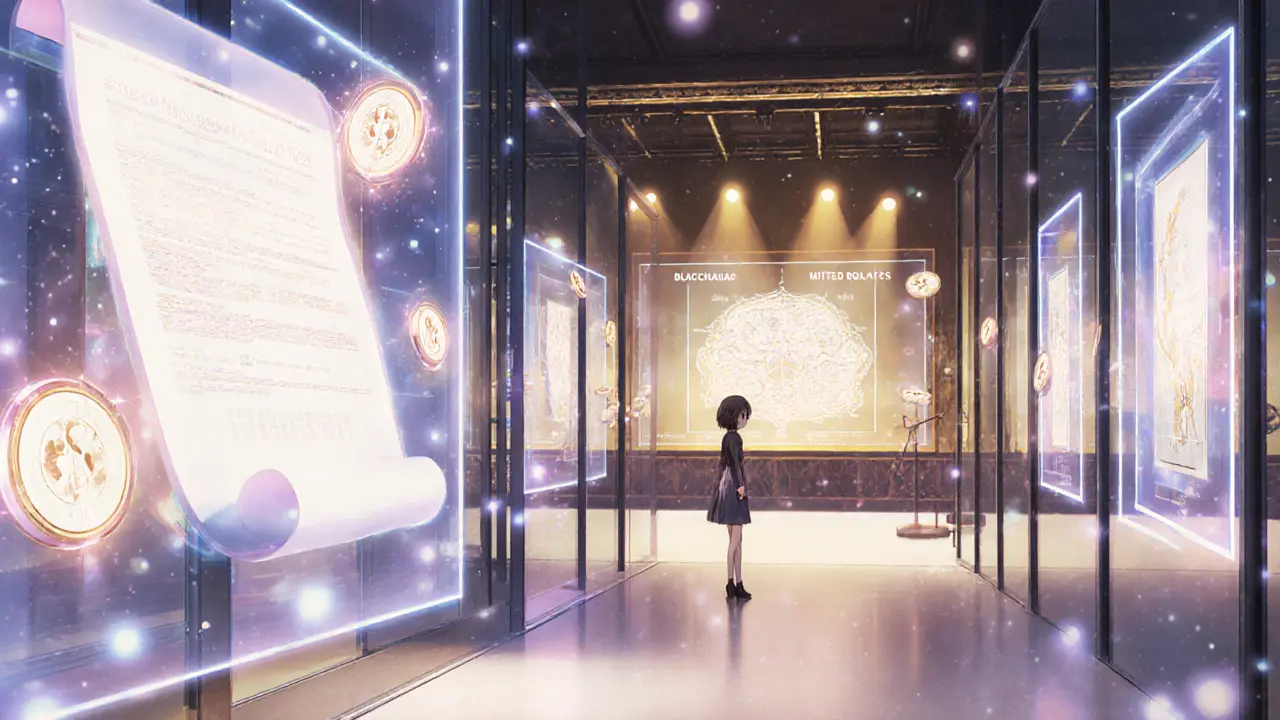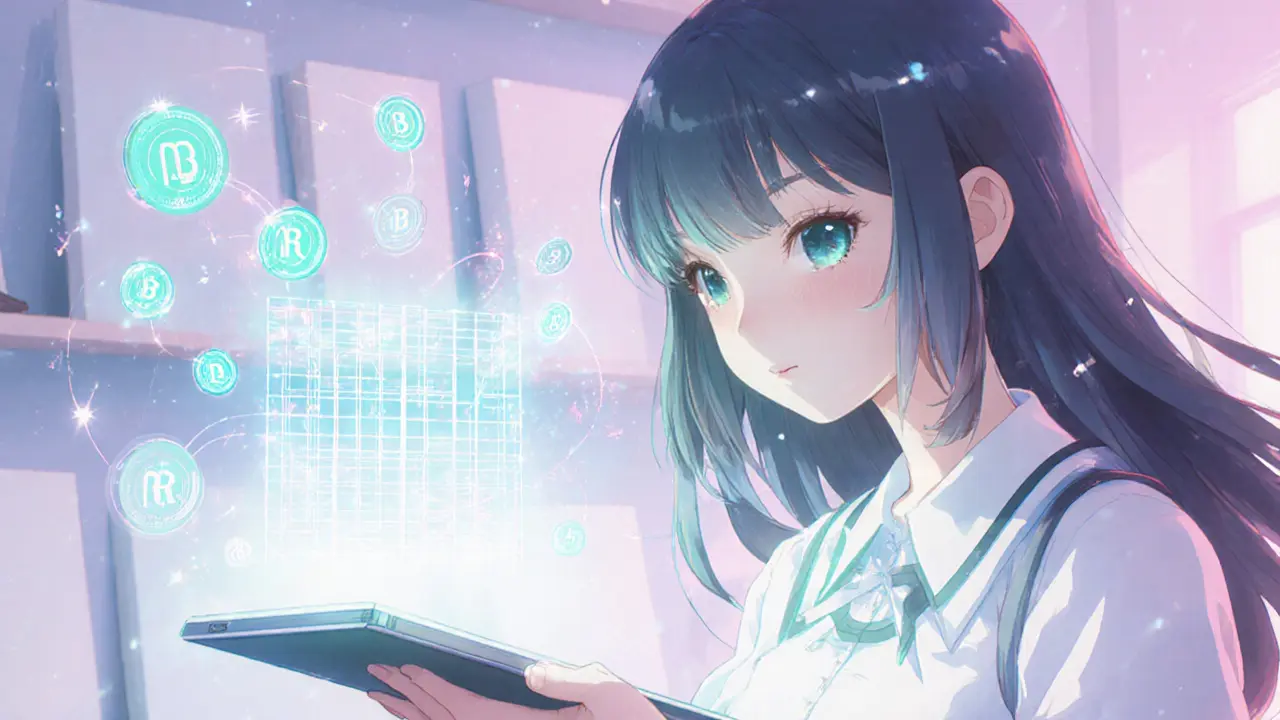When you hear the phrase blockchain art, you probably picture a pixelated picture sold for millions on a crypto marketplace. The reality is far richer: digital creators are now tapping a global, programmable ledger to prove ownership, earn royalties automatically, and even embed interactive experiences that evolve over time. This article untangles where the industry is headed, why new technologies matter, and how artists and collectors can stay ahead of the curve.
Key Takeaways
- The global digital‑art market is set to triple by 2032, growing at a 17.3% CAGR.
- AI‑powered NFTs and utility‑focused tokens are reshaping value beyond simple speculation.
- Proof‑of‑stake chains like Solana cut energy use by over 99% compared with early‑stage Ethereum.
- Fractional ownership and DeFi integration turn artworks into tradable financial assets.
- Artists can launch a credible collection in 2‑4 weeks with the right wallet and marketplace.
Market Momentum: Numbers That Matter
According to the latest industry forecast, the digital‑art segment will swell from USD 5.8billion in 2025 to USD 17.72billion by 2032. While pure NFT‑trading revenue is expected to dip to $479.1million in 2026, the broader ecosystem keeps expanding because creators are adding real‑world utility: exclusive event tickets, physical‑item bundles, and community‑only access.
Google Trends data reinforces that curiosity isn’t fading. Search interest rose from a score of 6 in August2024 to 36 by August2025, spiking when AI‑NFT collaborations were announced in March2025 and sustainability‑focused drops launched in June2025.
Technical Foundations: How Blockchain Powers Art
Digital Art is a form of creative expression that lives in electronic formats-images, video, 3D models, or immersive VR scenes. When artists anchor a piece to a distributed ledger, they gain an immutable certificate of authenticity.
Blockchain provides that ledger: a network of computers that collectively validate transactions without a central authority. Its core advantage for art is traceability-every transfer is recorded forever.
Non‑Fungible Token (NFT) is the token standard that represents a unique asset on a blockchain. Each NFT carries metadata pointing to the artwork, plus a smart contract that governs ownership rules.
Smart Contract is self‑executing code stored on the chain. For artists, the biggest breakthrough is royalty automation: the contract automatically sends a % of every resale back to the creator.
Two ecosystems dominate today: Ethereum, the original home of NFTs, and Solana, a proof‑of‑stake chain that boasts near‑instant finality and low fees. Both support popular marketplaces like OpenSea, which now offers layer‑2 options to curb gas costs.
Emerging Trends: From AI‑Generated Art to Utility Tokens
Artificial intelligence is no longer a gimmick; it’s becoming a co‑creator. AI‑powered NFTs can change colors based on weather data, evolve with viewer interaction, or generate new variations on the fly. Artists such as Refik Anadol and Takashi Murakami have showcased works that pull live data streams into the visual experience, turning a static image into a living piece.
Utility NFTs are another growth engine. Game developers now hand out character skins and in‑game items that retain value across multiple titles. Outside gaming, NFTs can unlock membership to private Discord servers, grant early‑bird tickets to concerts, or provide physical merchandise bundles. This shift from pure speculation to functional benefits drives higher collector loyalty.
Fractional ownership, powered by DeFi protocols, slices high‑value pieces into tradable tokens. A collector can own a 0.1% stake in a $500k digital painting, earn a proportion of resale royalties, and even use the token as collateral for a loan. This democratizes access and fuels secondary‑market liquidity.
Sustainability & Multi‑Chain Evolution
Environmental concerns have haunted the NFT space since the Ethereum proof‑of‑work era. Transitioning to proof‑of‑stake (PoS) cut energy consumption by over 99%, and chains like Solana and Polygon now process thousands of transactions per second with negligible carbon impact.
Layer‑2 scaling solutions-Optimism, Arbitrum, zk‑Rollups-bundle many transactions off‑chain before committing a single proof to the main chain. This reduces fees dramatically: a typical mint on Ethereum L2 can cost under $0.10, compared with $20‑$40 on mainnet in 2023.
Cross‑chain bridges are also maturing, allowing NFTs to move between ecosystems without losing provenance. Artists can mint on Ethereum for brand recognition, then bridge to Solana for a cost‑effective sale, and later return to Ethereum for a high‑profile auction.

Institutional Adoption: From Auction Houses to Galleries
Legacy institutions have begun treating blockchain art as a legitimate asset class. Sotheby’s now runs dedicated NFT auctions alongside its traditional sales, while Saatchi Art and Artnet host curated digital‑art exhibitions that feed directly into global marketplaces.
DeFi integration adds another layer: platforms now let collectors stake NFTs for yield, borrow against them, or participate in liquidity pools. This turns an artwork into a revenue‑generating instrument, appealing to investors looking for diversified exposure.
Corporate interest is rising as well. Brands are commissioning AI‑NFT campaigns to engage younger audiences, and universities are offering courses on blockchain‑based creative economies, signaling a pipeline of talent familiar with the tech.
Getting Started: A Practical Roadmap for Artists
- Set up a crypto wallet. MetaMask (Ethereum) and Phantom (Solana) are beginner‑friendly. Secure your seed phrase and enable two‑factor authentication.
- Choose a blockchain. If you prioritize low fees and sustainability, start on Solana or Polygon. For brand prestige, Ethereum remains the gold standard.
- Create or mint your artwork. Use tools like Adobe’s Generative Fill for AI‑assisted designs, then export the file (PNG, GIF, MP4) and upload to a marketplace.
- Deploy a smart contract. Most platforms offer a “lazy mint” option that creates the contract only when the first buyer purchases, saving upfront gas.
- Set royalty terms. Typical rates range from 5‑10% per resale. This ensures long‑term income as your work circulates.
- Promote and build community. Share behind‑the‑scenes on Twitter/X, Discord, or Instagram. Offer token‑gated perks to turn casual fans into patrons.
The learning curve for basic minting is roughly two weeks; mastering advanced features like dynamic NFTs or fractionalization can take three months of focused study.
Risks and Challenges to Watch
Even with bright prospects, several hurdles remain:
- Transaction fees. While layer‑2 solutions help, spikes in network demand can still make minting pricey.
- Market volatility. Prices can swing wildly, affecting both primary sales and secondary royalties.
- Technical complexity. Non‑technical artists may feel overwhelmed by wallet security, gas management, and smart‑contract nuances.
- Regulatory uncertainty. Some jurisdictions are still defining how NFTs fit into securities law, which could impact cross‑border sales.
- Environmental perception. Although PoS mitigates impact, lingering skepticism about crypto’s carbon footprint persists among eco‑conscious buyers.
Mitigation strategies include using eco‑friendly chains, offering off‑chain verification badges, and staying informed about local regulations.
Ethereum vs. Solana: Quick Comparison
| Aspect | Ethereum | Solana |
|---|---|---|
| Consensus | Proof‑of‑Work (transitioning to PoS) | Proof‑of‑Stake |
| Typical Mint Cost | $15‑$30 (mainnet) / <$0.10 (L2) | ~$0.01‑$0.05 |
| Transaction Speed | 15‑30sec (mainnet) | ~400ms |
| Energy Consumption | ≈60kWh/tx (pre‑PoS) | ≈0.0005kWh/tx |
| Marketplace Ecosystem | OpenSea, Rarible, Foundation | Magic Eden, SolSea |
| Developer Tools | Solidity, Hardhat, Truffle | Rust, Anchor, Solana SDK |
Looking Ahead: 2026‑2032 Forecast
By 2028, we expect utility NFTs to dominate 45% of all new drops, with AI‑generated pieces accounting for another 30%. Traditional art houses will likely allocate dedicated exhibition space for mixed‑media blockchain collections, and fractional ownership platforms will list portfolios of both digital and physical assets.
Governments may begin issuing digital‑art registries that recognize NFTs as cultural heritage, providing tax incentives for creators. Meanwhile, the rise of “art‑as‑code” will empower programmers to embed interactive scripts directly into the token, opening a new genre of generative, self‑updating masterpieces.

Frequently Asked Questions
What is the biggest advantage of using NFTs for digital art?
NFTs give creators an immutable proof of ownership and enable automatic royalty payments every time the piece changes hands, something traditional digital files can’t enforce.
Do I need to know how to code to sell an NFT?
No. Most marketplaces offer a “lazy‑mint” UI where you upload your file, set a price and royalty, and the platform handles the smart‑contract creation behind the scenes.
Which blockchain should I choose for my first collection?
If you care about low fees and eco‑friendliness, start on Solana or Polygon. If brand prestige and broader market exposure matter more, Ethereum (especially on a layer‑2) remains the go‑to.
Can NFTs be linked to physical artworks?
Yes. Many creators issue a token that represents a fraction of a physical piece or includes a redemption code for the actual object, blending the digital and tangible worlds.
How do royalties work on resale?
The NFT’s smart contract contains a royalty percentage. When a secondary sale occurs on a compliant marketplace, the contract automatically redirects that slice of the sale price to the creator’s wallet.
What are the environmental concerns, and are they solved?
Proof‑of‑work blockchains like early‑stage Ethereum consumed a lot of energy. The shift to proof‑of‑stake and the rise of low‑energy chains have reduced carbon footprints by over 99%, making NFTs far greener than they once were.


Navneet kaur
May 17, 2025 AT 12:16People should stop using blockchain for selfies, it’s wastefull.
Marketta Hawkins
May 17, 2025 AT 12:18The US is already leading the NFT space, other countries just copy‑paste the same tired ideas 😊.
Drizzy Drake
May 17, 2025 AT 12:26Diving into the blockchain art scene can feel like stepping into a futuristic gallery that constantly reshapes itself.
First, understand that NFTs are more than just JPEGs; they are programmable assets that can evolve over time.
When you mint on a proof‑of‑stake chain, you’re already supporting a greener ecosystem, which many collectors appreciate.
Royalty smart contracts ensure that artists keep earning whenever their work changes hands, creating a sustainable income stream.
If you’re new, start with a reputable wallet like MetaMask or Phantom and secure your seed phrase-never share it.
Choose a blockchain that fits your goals; Ethereum offers prestige while Solana offers lightning‑fast, cheap transactions.
Take advantage of lazy minting if you’re budget‑conscious; it defers gas costs until the first sale.
Engage with your community on Discord or Twitter, because building a loyal fanbase amplifies visibility.
Consider adding utility to your NFTs, like exclusive event tickets or access to secret content, to boost real‑world value.
Fractionalization can open your work to investors who can’t afford the whole piece, expanding your market.
Layer‑2 solutions, such as Arbitrum or Polygon, can slash fees dramatically, making it easier for collectors to purchase.
Stay aware of market trends but don’t let hype dictate your creative direction.
Experiment with AI tools to generate dynamic art that reacts to data feeds or user interaction.
Document your process and share behind‑the‑scenes content; transparency builds trust.
Finally, keep learning-new protocols emerge regularly, and staying informed keeps you competitive.
Remember, patience and consistency are key; the digital art world rewards those who persist.
AJAY KUMAR
May 17, 2025 AT 12:43From the moment I first saw a digital canvas on a Solana block, I felt the thunder of a new artistic revolution roaring across the globe!
bob newman
May 17, 2025 AT 12:53Sure, the next big thing is fractional NFTs-because what we really needed was more ways for the elite to shackle us with tiny pieces of art, right?
Anil Paudyal
May 17, 2025 AT 13:00Nice overview, but watch out for gas spikes.
Kimberly Gilliam
May 17, 2025 AT 13:01Wow wow this is just another hype train no more insight
Jeannie Conforti
May 17, 2025 AT 13:03I think the guide is really helpful for beginners, just take it step by step and dont worry too much.
tim nelson
May 17, 2025 AT 13:05I get why you feel skeptical, the market can be a wild ride, but some creators truly benefit.
Zack Mast
May 17, 2025 AT 13:06When one peers into the ledger of creation, one sees that value is not merely assigned, but negotiated by the collective consciousness of the network.
Dale Breithaupt
May 17, 2025 AT 13:08Stay curious and keep experimenting-you’ll find your niche.
Rasean Bryant
May 17, 2025 AT 13:10The projected growth figures are encouraging, and with sustainable chains, the ecosystem is poised for responsible expansion.
Angie Food
May 17, 2025 AT 13:11Honestly this article just rehashes the same buzzwords, nothing new.
Jonathan Tsilimos
May 17, 2025 AT 13:13The convergence of tokenomics and decentralized ledger technology engenders a paradigm shift within the digital creative domain.
jeffrey najar
May 17, 2025 AT 13:15If you need help setting up a wallet or choosing a marketplace, feel free to ask-happy to guide you through.